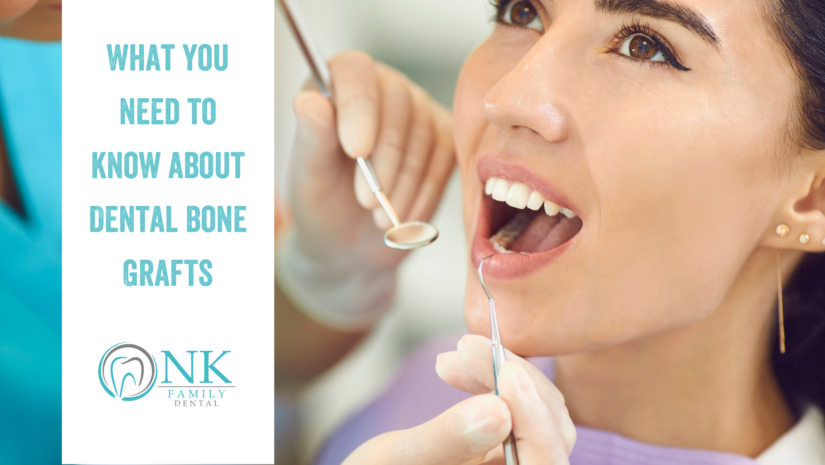
When it comes to bone grafts, the procedure sounds more frightening than it really is. Dental bone grafting is a well-established, proven treatment method that replaces missing bone in your jaw to provide a secure platform for dental implants, as well as to restore bone that has been reabsorbed as the result of periodontal (gum) disease. This is an in-office procedure requiring IV sedation — which means you’ll need someone to drive you to the appointment and back home — and is well-tolerated by the vast majority of patients. In other words, let our team at NK Family Dental put your mind at ease if your dentist or oral surgeon recommends a bone graft!
In this blog post, we will explain everything you need to know about bone grafts and the four different types you can receive. Continue reading to learn what to expect from the procedure, side effects, recovery, and aftercare.
How Does a Dental Bone Graft Work? Are There Different Types of Bone Graft Material?
A dental bone graft replaces missing bone in your jaw with bone grafting material to encourage regeneration. As your natural bone grows, it absorbs the graft material, resulting in a fully integrated region of new bone. Four types of bone grafting material exist:
- Autografts: Bone is taken from your own body from the tibia, hip, or another part of the jaw. Recovery from this procedure can be more difficult than other bone grafting procedures, as there are two surgical locations instead of one.
- Allografts: Allografts come from a human donor, usually a cadaver. The material undergoes treatments to sterilize it and prevent rejection by your body.
- Xenografts: This type uses the inorganic portions of animal bones, such as cows or pigs.
- Alloplasts: Alloplasts are made using synthetic material, such as calcium phosphate.
Because you are the donor for an autograft, two separate surgeries will be required. The other types require only one surgery. Autografts are considered the gold standard since they increase bony support in the jaw and promote faster healing and new bone formation. However, all types achieve successful results. Your dentist or oral surgeon will discuss each option with you.
What Does a Dental Bone Graft Procedure Involve?
A bone graft procedure typically involves five steps:
- Anesthesia. The type of anesthesia you’ll receive will be discussed during a consultation with your dentist or oral surgeon. This will typically be a local anesthetic to numb the surgical site. You may also need IV sedation in the case of an autograft, or if you experience dental anxiety.
- Extraction and/or bone sourcing. If you are using an autograph, the dentist or oral surgeon will source the bone from the chosen location. If you need a tooth removed, the surgeon will perform the tooth extraction at this time. Combining tooth extraction with bone grafting encourages faster healing.
- Graft insertion. Next, the area will be thoroughly cleaned. If you do not have an extraction, the dentist or oral surgeon will make an incision in the gum tissue to expose the bone. Then, he or she will attach the bone graft material to the exposed bone.
- Stitching. Once the graft material is in place, the area is sutured closed. The dentist or oral surgeon may use pins, plates, wires, cables, or even a titanium screw to hold the tissue together. If you source the bone from your body, the surgeon will also stitch that area together.
- Recovery. In most cases, you can return home the same day as your procedure, but as previously mentioned, you will need a driver if you received sedation or general anesthesia. It is recommended that someone stay with you for the following 24 hours to watch for signs of complications and to help you avoid risky situations (such as operating a stove) as the sedation gradually wears off. Also do not make important decisions, major purchases, or sign legal papers that day.
You will need four to six months — perhaps longer — to completely heal and be ready for your dental implant if that is the reason for the bone graft. Your dentist or oral surgeon will provide a list of detailed instructions to care for the area. Follow these closely to prevent failure or complications.
How to Prepare for a Bone Graft Procedure
During your consultation with your dentist or oral surgeon, give him or her a list of all medications — both prescription and over-the-counter — that you take. Include herbal supplements as well, as they can affect the body’s platelet production, which is extremely important to ensure the bone grafting procedure succeeds.
Before your procedure, your dental professional may ask you to stop certain types of medication. How far in advance you will have to stop the medication will depend upon the dosage you are taking, the type of medication, and the type of procedure you are having done.
If you start taking a new medication or supplement between the consultation and the day of the procedure, call the office and ask if you need to stop taking it. It is better to be prepared than to arrive the day of the procedure to discover it cannot be performed.
At the time you make your appointment, your dentist or oral surgeon will give you a detailed list of pre-surgical instructions. For example, you may be told to not eat or drink anything (even water) after midnight. Be sure to read and follow these instructions carefully.
Should I Expect Any Side Effects from a Bone Graft Procedure?
As this is a surgical procedure, some side effects are to be expected and are considered normal. Following your post-surgical instructions will help keep them to a minimum. Infection is a concern with any surgery, so be sure to take the full course of antibiotics prescribed to you.
Normal side effects include:
- Swelling and minor bleeding at the surgical site.
- Pain, which can be controlled by over-the-counter or prescription pain relievers, as recommended.
- Difficulty chewing and speaking.
If these side effects increase or persist beyond a week, call your dentist or oral surgeon.
Abnormal side effects include:
- Blood clots.
- Nerve damage.
- Anesthesia complications.
- Rejection of the bone graft.
Signs of trouble include:
- Pain that persists or worsens several days after the procedure.
- Redness and increased swelling around the gums.
- Persistent tingling or numbness.
If you experience any of these abnormal side effects, call your dentist or oral surgeon immediately.
Conclusion and the Take-Home Message
Fortunately, a dental bone graft is a safe, uneventful procedure for the vast majority of people. Of course, a positive outcome that gives you a solid foundation for a dental implant or restoration after periodontal disease depends upon the experience and skill of the dentist or oral surgeon you chose.
We understand that the main concern you may have is cost, which is why we accept all major PPO plans for dental insurance and also offer our in-house dental plan. Please see our financing page for more information.
At NK Family Dental, it is our mission to provide the highest quality and most compassionate oral care to our Chicago patients, including both dental and periodontal services. Our dental specialists include our general dentist, Dr. Nilofer Khan, our periodontist, Dr. Amir Danesh, and our endodontist, Dr. Sabek.
We serve the neighborhoods of Logan Square, Bucktown, Humboldt Park, and Wicker Park with the dedication that’s earned us the reputation as the Best Dentist in Chicago!
Schedule your visit through ZocDoc, or contact us directly. We look forward to treating you soon!
